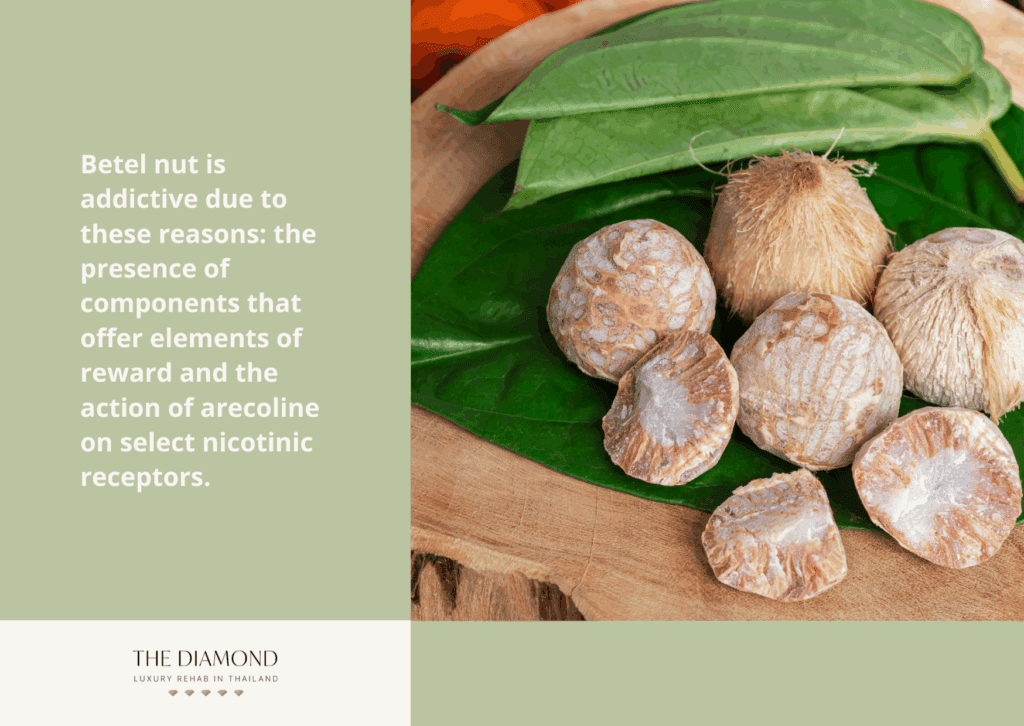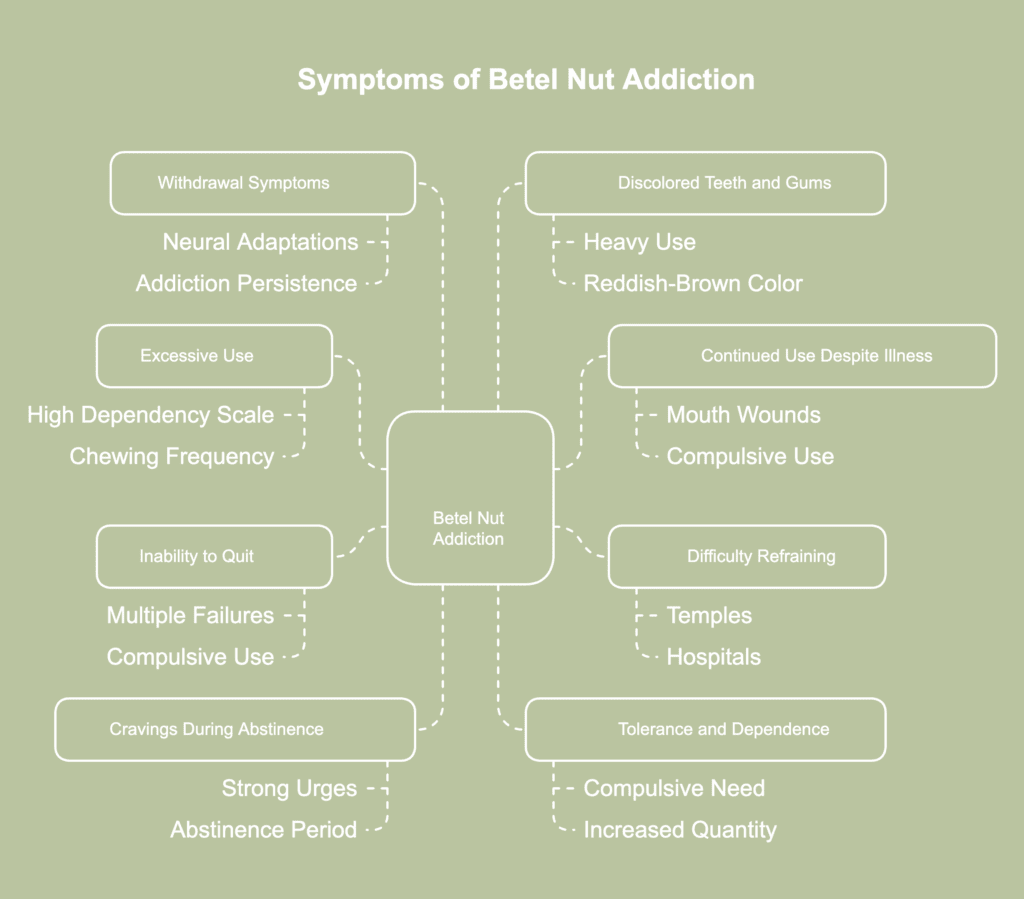Betel nut addiction: definition, symptoms, and how to overcome

Betel nut is the seed of the Areca palm tree. It is typically chewed in the form of betel quid, with or without tobacco. Betel nut possesses psychoactive properties that are known to cause tolerance, dependence, and withdrawal that lead to the development of addiction.
The symptoms of betel nut addiction are uncontrolled and excessive use of the substance, persistent use despite illness and wounds, difficulty refraining from using it in situations where use is prohibited, and an inability to quit despite wanting to. Other symptoms include experiencing cravings; developing tolerance, dependence, and withdrawal; and having discolored teeth and gums.
Betel nut addiction is overcome by learning about the adverse health effects of the substance and using this knowledge to spur motivation to quit. Other strategies include learning to say no when offered betel nut in social gatherings, chewing or sucking on gums or throat lozenges instead of betel nut, practising mindfulness exercises, and addressing mental stress with appropriate therapy.
Is betel nut addictive?
Betel nut is addictive and has the potential to cause tolerance, dependence, and withdrawal among long-term and heavy users. It is a psychoactive substance that alters neural chemistry and brain functionality that contribute to the development and maintenance of addiction.
Betel nut is a stimulant drug and a carcinogen. However, a lack of awareness about its adverse health effects and addictive potential along with its widespread traditional and customary usage in multiple regions of the world contributes to the development of betel nut addiction.
How common is betel nut addiction?
Betel nut addiction is common around the world with dependence being reported among 20%-90% of the current 600 million users, according to a 2020 article by Ko et al., published in the journal Progress in Neuro-psychopharmacology and Biological Psychiatry, titled “Betel quid dependence mechanism and potential cessation therapy.” The 12-month prevalence of betel quid disorder was observed to be 83% of active users. A study on students aged 10-19 years in India revealed the prevalence of betel nut addiction to be 21.6%, according to a 2020 article by Pandya et al., published in the International Journal of Contemporary Pediatrics, titled “Tobacco and betel nut use among school going adolescents of South Gujarat region, India: a cross sectional study.”
Why is betel nut addictive?

Betel nut is addictive due to these reasons: the presence of components that offer elements of reward and the action of arecoline on select nicotinic receptors. Betel nut contains high amounts of GABA (gamma-aminobutyric acid) and glutamate, which stimulate the GABA and glutamate receptors in the brain. A complex interplay of GABA and glutamate neurotransmitters is involved in the functioning of the reward circuitry. Betel nut use stimulates activity in the brain’s reward region. The resulting release of neurotransmitters like dopamine induce short-term reinforcing effects, which is one of the components of addiction, according to a 2022 article by Stokes et al., published in the journal Addiction Biology titled “Betel quid: New insights into an ancient addiction.”
Arecoline is an alkaloid present in betel nut. It acts on specific subtypes of the nicotinic acetylcholine receptor (nAChR) that are implicated in nicotine addiction, according to a 2015 article by Papke et al., published in the journal PLoS One, titled “Nicotinic Activity of Arecoline, the Psychoactive Element of “Betel Nuts”, Suggests a Basis for Habitual Use and Anti-Inflammatory Activity.” Arecoline’s action on nAChR is believed to produce physical dependence on betel nut after long-term use.
The development of physical dependence that results in the manifestation of withdrawal syndrome is a component of severe addiction. Stokes et al., (2022) mention that betel nut has the ability to block dopamine and serotonin transporters, resulting in the stimulant- and antidepressant-like properties of the substance. These properties likely contribute to the addiction-promoting nature of betel nut.
What is betel nut?
Betel nut, also known as areca nut, is the fibrous seed of the Areca catechu or areca palm tree, which grows in the tropical regions of the world and most notably in Asia, eastern Africa, and the Pacific. It is typically chewed along with additives like tobacco. It is primarily consumed as part of social traditions in specific regions of the world and for its psychoactive properties.
Why do people consume betel nut?
People consume betel nut to experience feelings of well-being, reduce mental stress, and enhance alertness.Other prominent reasons for consumption include boredom, peer pressure, and family tension, according to a 2021 article by Athukorala et al., published in the Journal of Addiction, titled “Areca Nut Chewing: Initiation, Addiction, and Harmful Effects Emphasizing the Barriers and Importance of Cessation.” A study on Taiwanese adolescents revealed that they initiated betel nut use out of curiosity and to keep warm.
Outdoor workers, such as fishermen, construction workers, and drivers who travel long distances, consume betel nut to keep away thirst and feel warm. Betel nut is also consumed as a mouth freshener and to aid digestion. In India, individuals report consuming betel nut to manage symptoms of asthma, cough, dermatitis, glaucoma, intestinal worms, leprosy, toothache, impotence, vaginal discharge, and vaginal laxity.
Betel nut chewing is an important cultural practice in various regions of south and south-east Asia and the Asia Pacific. Individuals in these regions tend to consume betel nut as part of their sociocultural customs. It has been observed that in regions where betel nut chewing is an accepted social practice, adolescents are initiated into usage by their parents and family members. On the other hand, individuals with betel nut addiction consume the substance because they have become dependent on it.
Is betel nut considered a drug?
Yes, betel nut is considered a drug. It is classified as a stimulant, meaning that it stimulates the central nervous system. It is the fourth most consumed psychoactive agent in the world, after nicotine, alcohol, and caffeine. Despite its harmful health effects, addictive properties, and classification as a carcinogen, betel nut is sold as an unregulated agricultural product in most regions in the world, according to a 2012 report by the World Health Organization titled “Review of Areca (Betel) Nut and Tobacco Use in the Pacific: A Technical Report.” Betel nut is not classified as a controlled substance in the US. However, the Food and Drug Administration lists it on its Poisonous Plants Database and the National Institute on Drug Abuse lists it on its Emerging Drug Trends webpage. In Australia, arecoline, the active ingredient of betel nut, is classified as Schedule 4 poison.
What does betel nut do to the brain?

Betel nut affects brain function and connectivity and alters the concentration and balance of neurotransmitters. The substance acts on the frontal, temporal, and parietal brain regions, according to a 2020 article by Sariah et al., published in the journal Frontiers in Psychiatry, titled “Acute and Chronic Effects of Betel Quid Chewing on Brain Functional Connectivity.” Individuals who are chronic users of betel nut have been observed to have higher functional connectivity in these regions compared to those of the control group. The acute effects of betel nut consumption on these regions manifest as enhanced functionality in specific visual cortical areas, the thalamus, and basal ganglia.
Betel nut use is shown to increase concentrations of serotonin and noradrenaline in the brain, according to a 2020 article by Ko et al., published in the journal Progress in Neuro-psychopharmacology and Biological Psychiatry, titled “Betel quid dependence mechanism and potential cessation therapy.” Arecoline possesses properties that mimic those of monoamine oxidase-A (MAO-A) inhibitors, such as increasing the levels of dopamine and serotonin in the brain. Arecoline’s actions on nicotinic and muscarinic receptors is believed to influence drug impact on the brain, according to a 2017 article by Huang et al., published in the journal Frontiers in Psychiatry, titled “Altered Brain Functional Connectivity in Betel Quid-Dependent Chewers.” The effects include euphoria, a sense of well-being, and increased alertness. The acute effects of betel nut consumption include reduction in the ability to think, disturbed mental processes, and increased motor reactions (Sariah et al., 2020). Through its action on the brain’s reward pathway, betel nut influences mental processes implicated in reward salience and reinforcement learning. Dysregulation of these processes contributes to the transition from intermittent substance use to habitual, compulsive, and uncontrolled drug-taking behaviors.
What does betel nut taste like?
Betel nut has an astringent, slightly bitter and woody taste with spicy undertones of nutmeg and cinnamon when the fruit is raw. Green or immature betel nut fruits have a stronger vegetal taste than the ripe yellow-orange ones. Depending on customer preferences, the characteristic taste of betel nut is modified by marinating the nut with additives like sweeteners. The additives release their flavors when the nut is chewed. Betel nut is sundried, baked, roasted, or boiled and fermented to alter its taste and astringency.
How does betel nut make you feel?
Betel nut makes you feel euphoric, alert, and energetic. There is a feeling of well-being, increased salivation, sweating, and a hot sensation flowing through the body after having betel nut, according to a 2001 article by Nan-Shin Chu published in the Journal of Biomedical Science, titled “Effects of betel chewing on the central and autonomic nervous systems.” Individuals feel warm and their faces redden. The heart rate and blood pressure increase and the individual experiences palpitations. These effects are caused by betel nut’s actions on the sympathetic, parasympathetic, and central nervous systems.
How is betel nut consumed?
Betel nut is consumed raw–ripe or unripe– or in a processed form. It is dehydrated and cured by roasting, baking, or drying in the sun before consuming. Boiling and fermenting it by covering it in mud is another technique of processing betel nut before consumption. It is commonly taken with betel leaf, betel flower, slaked lime, tobacco, and catechu, as noted in the chapter “Betel-quid and Areca-nut Chewing” from the 2004 book titled “Betel-quid and Areca-nut Chewing and Some Areca-nut-derived Nitrosamines” published by the International Agency for Research on Cancer. A popular betel nut preparation is the betel quid. Thinly-sliced or grated nuts are placed on a betel leaf, smeared with slaked lime or crushed seashells, and rolled to form a small parcel. Often tobacco, coconut, sugar, syrup, fruit extract, mustard, turmeric, cardamom, cloves, aniseed, nutmeg, or saffron are added to the betel quid to enhance its taste. Betel nut and tobacco are consumed together, without the betel leaf, in various regions of the world where betel nut consumption is culturally prevalent.
What is the history of betel nut chewing?
The history of betel nut chewing predates written records, according to a 2022 article by Stokes et al., published in the journal Addiction Biology titled “Betel quid: New insights into an ancient addiction.” There are references to betel nut chewing in ancient Chinese, Greek, and Sanskrit literature dating back as early as 1st century BC, according to a 2011 article by S.C. Ahuja and Uma Ahuja published in the journal Asian Agri-History, titled “Betel leaf and betel nut in India: History and uses.” Historians in Sri Lanka (then Ceylon) and Iran (Persia) around 600 AD refer to the practice of using betel nut. It is known to have been used in Arab regions during the 8th and 9th centuries. Marco Polo introduced Europe to betel nut around 1300 AD. Its use is traced back as far as 2,000 years in Guam and other regions of the Pacific Basin.
What are the symptoms of betel nut addiction?

The symptoms of betel nut addiction are listed below.
- Excessive use: Uncontrolled usage is a characteristic of addiction. According to the findings of a survey, betel nut-using individuals who scored high on the dependency scale reported greater frequency of chewing, as noted in a2010 article by Bhat et al., published in the journal Addiction, titled “Areca Nut Dependence Among Chewers in a South Indian Community Who Do Not Also Use Tobacco.”
- Continued use despite illness or wounds: Individuals addicted to betel nut tend to display persistent usage even when they are ill or have wounds in their mouth. This indicates compulsive use, which is a hallmark of addiction.
- Difficulty refraining from use in situations where use is prohibited: Individuals find it difficult to refrain from chewing betel nut in places where its use is typically prohibited, such as temples, hospitals, and on public modes of transportation.
- Inability to quit despite intending to: Failing to quit using betel nut despite wanting to or failing multiple times indicates compulsive use of the substance.
- Experiencing cravings during abstinence: About 25% of the respondents in a survey measuring betel nut dependency reported experiencing strong cravings for the substance if they went more than two hours without chewing (Bhat et al., 2010).
- Development of tolerance and dependence: It is possible for habitual users of betel nut to develop dependence on the substance and/or become tolerant to its effects.Dependence manifests as a compulsive need to use betel nut to be functionaland perform routine tasks like studying, working, and socializing. Tolerance manifests as needing to take increasingly larger quantities of betel nut to experience the earlier effects.
- Manifestation of withdrawal symptoms: The manifestation of withdrawal symptoms indicates dependence on betel nut. Dependence is caused by long-term and/or excessive use of betel nut resulting in neural adaptations that contribute to the development and persistence of addiction.
- Discolored teeth and gums: Heavy use of betel nut stains the teeth and gums to a reddish-brown color. In individuals who chew betel nut, discolored teeth and gums is an indication of excessive use.
What are the effects of betel nut addiction?

The effects of betel nut addiction are listed below.
- Discolored gums and teeth: Chewing betel nut produces red-colored saliva. Habitual betel nut chewing stains the teeth and the gums. The color ranges from red to black depending on the duration of use and the additives taken.
- Damage to oral and dental health: Betel nut addiction has been shown to cause tooth fracture, periodontal disease, and lichenoid lesions, according to a 2020 article by M. Shirzaiy and F. Neshat published in the Journal of Research in Dental and Maxillofacial Sciences, titled “Effect of Areca Nut on Oral Health: A Review.” Betel nut is known to aggravate the symptoms of existing periodontal disease.
- Increased risk of developing oral cancer: Betel nut consumed in any form is known to cause oral cancer, according to a 2021 article by Athukorala et al., published in the Journal of Addiction, titled “Areca Nut Chewing: Initiation, Addiction, and Harmful Effects Emphasizing the Barriers and Importance of Cessation.” The majority of individuals who have been chewing betel nut for prolonged periods develop oral potentially malignant disorders like submucous fibrosis, oral leukoplakia when the substance is used with tobacco, or erythroplakia. These conditions are regarded as early and significant indicators of oral cancer risk.
- Increased risk of developing other forms of cancer: Betel nut is classified as a Group I oral carcinogen by the International Agency for Research on Cancer. Betel nut addiction is known to increase the risk of developing cancers of the larynx, lungs, esophagus, liver, and pancreas (Athukorala et al., 2021). The risk is magnified when slaked lime is taken while chewing. Slaked lime increases the pH of the oral cavity causing inflammation and triggering oxidation of the polyphenols in betel nut. The reactive oxygen compounds produced are known to cause cancers. Betel nut contains known carcinogens like the alkaloids arecaidine, arecoline, guvacoline, and guvacine; polyphenols like catechins, hydroxychavicol, and safrole; and tannins.
- Gastrointestinal complications: It has been found that habitual betel nut chewers carry a high proportion of Helicobacter pylori (H. pylori) in the digestive tract compared to those non-betel chewers, according to a 2009 article by Fernando et al., published in the journal BMC Oral Health, titled “Presence of Helicobacter pylori in betel chewers and non betel chewers with and without oral cancers.” H. pylori is implicated in the development of peptic ulcer, gastric MALT (mucosal associated lymphoid tissues), and distal gastric cancer. It is possible for betel nut addiction to trigger “congestion” in the intestines and thus, exacerbate the symptoms in individuals with intestinal blockage.
- Increased risk of seizures: Habitual betel nut consumption has been linked to an increased risk of having seizures, according to a2003 article by Huang et al., published in the journal Seizure, titled “Betel nut indulgence as a cause of epilepsy.” The authors suggest possible contributory mechanisms like the action of arecoline on specific neural receptors, substance-induced increases in the plasma concentration of epinephrine and norepinephrine, and an imbalance of the gamma-aminobutyric acid (GABA) neurotransmitter.
- Increased risk of physical health complications: Arecaidine and arecoline, the alkaloids present in betel nut, are known to trigger adverse physiologic and metabolic effects on the cardiovascular system, brain, pancreas, and lungs, according to a 2008 article by Lin et al., published in The American Journal of Clinical Nutrition, titled “Betel nut chewing is associated with increased risk of cardiovascular disease and all-cause mortality in Taiwanese men.” Betel nut addiction increases the risk of developing type 2 diabetes, obesity, hypertension, metabolic syndrome, hyperlipidemia, cardiovascular disease, and chronic kidney disease.
- Tolerance: It is possible for regular users of betel nut to develop tolerance to it. They feel they need to take the substance in increasing amounts to experience the desired effects.
- Dependence: The habitual use of betel nut has been linked with the development of a dependence syndrome in a significant number of users, according to a 2008 article by Benegal et al., published in the journal Drug and Alcohol Dependence, titled “Does areca nut use lead to dependence?”ˋ
- Harm to fetal and neonatal health: The alkaloid arecoline has the potential to cause damage to the placenta with serious fetal and/or maternal health complications. Babies born to mothers who are addicted to betel nut exhibit neonatal withdrawal syndrome. Betel nut addiction in mothers is known to cause low birth weight in newborns.
- Social, financial, and occupational problems: Substance abuse negatively impacts the individual with the addiction issue as well as their loved ones. Betel nut addiction is linked to multiple negative health outcomes. The expenses incurred to sustain this habit and treat the health issues triggered or aggravated by this addiction exert a significant burden on household incomes. It is possible that the ailing health of the addicted individuals renders them incapable of working and earning to support their loved ones.
How can a person overcome betel nut addiction?
To overcome betel nut addiction, learn about its severe negative health effects and how addictive it is. It is difficult to be convinced about the harms of chewing betel nut if the physical effects have not yet manifested. So, search for health information resources that include statements by or case studies of individuals who are contemplating quitting the use of betel nut after experiencing its negative effects or have cancer that was caused by their use of the substance. Learn about how betel nut addiction harms families and causes occupational and financial problems. Knowledge is a powerful motivational tool and creates and sustains the willpower required to exercise self-control.
Recognizing the negative physical effects of betel nut use and how an individual’s addiction to the substance affects their families has been shown to contribute to successful quitting experiences, according to a 2016 article by Tsui-Yun Yang and Hung-Ru Lin published in the Journal of Clinical Nursing, titled “Taking Actions to Quit Chewing Betel Nuts and Starting a New Life: Taxi Drivers’ Successful Experiences of Quitting Betel Nut Chewing.” Chewing betel nut is a socially acceptable practice in many cultures, so it is common to be offered these substances at social gatherings. Learn how to decline politely, but firmly. Keep gum or throat lozenges handy and chew or suck on them whenever an urge arises to use betel nut.
Betel nut users report that they tend to use the substance when they are stressed. Adopt measures like practising relaxation techniques and/or undergoing behavioral therapy to address mental stress. Studies on habitual betel nut users who were able to quit successfully have shown that exerting willpower to not use the substance was the main reason behind their success. Practice mindfulness exercises that are known to increase willpower and improve impulse control by helping individuals stay in the present and observe their thoughts without reacting.
What are the symptoms of betel nut withdrawal?

The symptoms of betel nut withdrawal are listed below.
- Cravings: Cravings are characterized by powerful urges or desires to experience the previously-felt pleasurable effects of a psychoactive substance. These urges are triggered by external stimuli like substance cues and internal stimuli like mental stress.
- Feelings of discomfort or distress: The findings from a study on a population of habitual betel nut users note that 27% of those who experienced an extended period of abstinence reported feeling uncomfortable, according to a 2010 article by Bhat et al., published in the journal Addiction, titled “Areca Nut Dependence Among Chewers in a South Indian Community Who Do Not Also Use Tobacco.” A majority of these individuals scored high on dependence markers.
- Anxiety and irritability: Betel nut stimulates the parasympathetic nervous system, which is responsible for inducing feelings of relaxation and calmness. After becoming accustomed to the presence of betel nut, the parasympathetic nervous system exhibits decreased levels of activity during a period of withdrawal from the substance. This manifests as symptoms like anxiety and irritability.
- Dysphoria : Arecoline posseses monoamine oxidase inhibitor (MAOI) like properties that mimic the function of an antidepressant. It is likely that individuals dependent on betel nut experience symptoms like low mood when they stop using the substance.
- Dry mouth: Long-term chewers of betel nut experience a condition called xerostomia, or dry mouth, according to a 2022 article by Sarode et al., published in the journal Medical Hypotheses, titled “Hygroscopic nature of betel quid: A cause for acinar cell degeneration and xerostomia.” It is caused by damage to the salivary glands.Betel nut addiction is also known to cause altered taste sensations.
- Fatigue: Chewing betel nut triggers a temporary increase in sympathetic nervous system activity. The resulting elevations in plasma concentrations of adrenaline and noradrenaline cause an increase in stamina. It is possible for an individual addicted to betel nut to feel tired and lethargic when they abstain from the substance.
- Reduced focus: Arecoline, an alkaloid in betel nut, activates the select nicotinic AChR (nAChR) receptor, thereby improving focus. So, betel nut withdrawal induces symptoms like reduced attention span.
What are the differences between betel nut and tobacco?
The differences between betel nut and tobacco stem from their biological and chemical characteristics. The differences are described in the table below.
| Betel Nut | Tobacco |
|---|---|
| Betel nut is the seed of the Areca catechu or areca palm tree. | Tobacco is obtained from the leaves of the plants belonging to the Nicotiana family. |
| Its primary active ingredient is arecoline, an alkaloid. | Its active ingredient is nicotine. |
| It is typically chewed in the form of betel quid. | The primary method of consumption is inhaling the smoke of cigarettes, cigars, and pipes. |
| Long-term betel nut chewing stains the teeth and gums reddish-brown. | Long-term use of tobacco stains the teeth yellow. |
| There is currently no effective medical treatment for betel nut addiction. | Tobacco addiction is managed by nicotine replacement therapy. |


